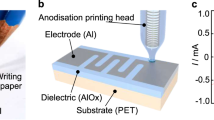Abstract
Flexible Magnetics encompases the design, fabrication and characterization of magnetic devices and systems built on thin flexible substrates. Although device and system functionality is magnetic in nature, flexible magnetics draws interesting parallels to flexible electronics, especially in the challenge of fabrication on plastic substrates. Some of those challenges include substrate surface quality and maximum processing temperature, tooling issues related to mechanical properties of flexible substrates, adhesion of thin films deposited on plastics, as well as thermal stability of fabricated devices.
One application of flexible magnetics relevant to the information storage industry is magnetic lithography. Magnetic lithography is a process qualitatively analogous to contact optical lithography. Magnetic lithography transfers information from a patterned magnetic mask (analogous to the optical photomask) to magnetic media (analog of the photoresist), and is interesting for applications in rapid, parallel magnetic recording. The magnetic mask consists of patterned magnetically soft material (FeNiCo, FeCo) on a thin flexible plastic substrate, typically Polyethylene Teraphtalate (PET) or polyimide. When uniformly magnetized media is brought into intimate contact with the magnetic mask, an externally applied magnetic field selectively changes the magnetic orientation in the areas not covered with the soft magnetic material. The flexible magnetic mask offers superior compliance to contaminated or nonplanar magnetic media. We discuss nanofabrication challenges of magnetic masks on plastic substrates, including electron beam lithography, electroplating and lift-off processing on the nanometer scale, adhesion of metal thin films on PET and polyimide substrate, and release of plastic films from the rigid substrates used during the processing. We present results on fabricated magnetic masks, and magnetic force microscopy images of the magnetic transition patterns.
Besides fabrication of magnetic nanostructures and devices on plastic substrates, we also present our results on nanoscale patterning of plastic thin film. We will present our results on fabrication of sub-100 nm scale nanochannels in polyimide films, as well as self-assembly of ordered arrays of polyimide nanodots. Nanoscale patterned plastic films are interesting for the potential application in magnetic lithography, as well as for the application in micro- and nanofluidics, due to the mechanical flexibility and biological inertness of plastic materials. We will discuss interesting biosensing systems that may result from the combination of magnetic functionality, electronic control and patterned nanofludic channels on plastic substrates.
Similar content being viewed by others
References
W.R. Bernard, W.S. Buslik, US pat. 3,869,711
Z.Z. Bandić, H. Xu, T.R. Albrecht, Appl. Phys. Lett. 82, 147 (2003).
Z.Z. Bandic, H. Xu, J.E.E. Baglin, and T.R. Albrecht, Mat. Res. Soc. Symp. Proc. 769, 227 (2003).
Z.Z. Bandić, Y. Hsu, H. Xu, T.R. Albrecht, IEEE Trans. Magn. 39, 2231 (2003).
S. Tanaka, Y. Imai, O. Morita, D. Dericotte, K. Kurokawa, T. Kashiwagi, and H. Takino, IEEE Trans. Magn. 30, 4209 (1994).
B.D. Terris, L. Folks, D. Weiler, J.E.E. Baglin, A.J. Kellock, H. Rothuizen and P. Vettiger, Appl. Phys. Lett. 75, 403 (1999).
A. Dietzel, R. Berger, H. Grimm, W.H. Bruenger, C. Dzionk, F. Letzkus, R. Springer, H. Loeschner, E. Platzgummer, G. Stengl, Z.Z. Bandić, and B.D. Terris, IEEE Trans. Magn. 38, (2002).
A. Saito, E. Yonezawa, Y. Takano, and T. Watanabe, J. Appl. Phys. 91, 8688 (2002).
H. Xu, T.E. Dinan, E.I. Cooper, L.T. Romankiw, C. Bonhote, and D. Miller, Proc. of the Electrochem. Soc, PV 2001-8.
J.E.E. Baglin, Intreface Design for Thin Film Adhesion, Fundamentals of Adhesion, ed. by L-H. Lee, Plenum Publ. Corp., 13 (1991).
K-S. Kim and J. Kim, Trans. ASME 110, 266 (1988).
R.H. Austin, J.O. Tegenfeldt, H. Cao, S.Y. Chou, and E.C. Cox, IEEE Trans. Nanotech. 1, 12 (2002).
C. Bustamante, J.C. Macosko, and G.J.L. Wuite, Nature Reviews 1, 130 (2000).
P.F. Garcia, R.S. McLean, M.H. Reilly, and G. Nunes, Appl. Phys. Lett. 82, 1117 (2003).
Author information
Authors and Affiliations
Rights and permissions
About this article
Cite this article
Bandić, Z.Z., Albrecht, T., Bonhote, C. et al. Flexible magnetics on plastic substrates: magnetic lithography, magnetic nanostructures and other applications. MRS Online Proceedings Library 814, 317–328 (2004). https://doi.org/10.1557/PROC-814-I9.3
Published:
Issue Date:
DOI: https://doi.org/10.1557/PROC-814-I9.3




